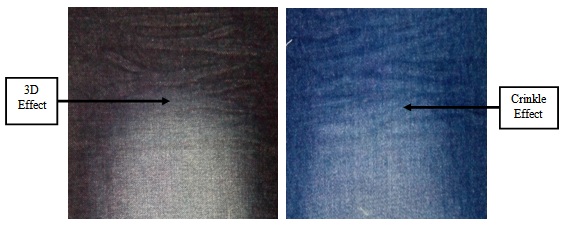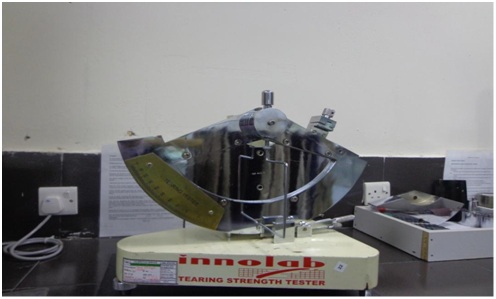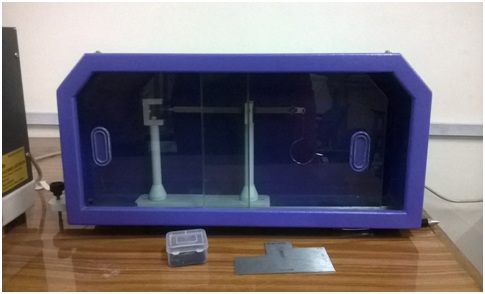Now You Know Latest Dry Washing Techniques in Denim Garments (Part-4)
Monday, 21 January 2019
Edit
Latest Dry Washing Techniques in Denim Garments (Part-4)
Asma Akhi
& Md.Hasibur Rahman Sunny
Dept. of Textile Engineering
Bangladesh University of Business & Technology
& Md.Hasibur Rahman Sunny
Dept. of Textile Engineering
Bangladesh University of Business & Technology
Previous Part
For Crinkle/3D:
Chemical: Resin (Catalyst, Silicone & PU solution)
Instrument: Pressing Crinkle Machine, Iron Machine, Dryer etc
Method:
First have to do spray resin on the specific area we want to create 3D effect. Without resin spray 3D effect is not possible. A garment is in metal plate. Resin (Formaldehyde free) being used for achieving 3D effect (3 Dimensional), Rigid Look etc. This process can be done by spraying or dipping the garments in to Resin, Catalyst, Silicone & PU solution in right combination according to the fabric strength & desired effect needed.
After application of resin solution in right proportion, make manual designing as needed on the thigh, hip & back knee area to get 3Dimentional effect. After making it, it should be manually dried with hot press or hair dryer & The temperature is 1900c, it deep the resin and then it send to the curing to make crinkle. Then must be cured in oven at right temperature, time as mentioned in resin product manual.
If resin not cured properly, 3D effect will not be permanent & can cause skin irritation to the wearer. Highly skilled operators need to execute this process in order to get consistency & uniformity.
 |
| Fig 13: 3D Sample Fig 14: Crinkle Sample |
| No. of Sample | 07 |
| M:L | 1:80 |
| Temperature | 450c,600c,700c |
| Time | 114min(All Wet Process) |
Working Recipe:
Neutral Wash:
Types of Instrument Used for Testing:
Testing & Procedure:
Following test are done:
The GSM of fabric is one kind of specification of fabric which is very important for a textile engineer for understanding and production of fabric. ‘GSM’ means ‘Gram per square meter’ that is the weight of fabric in gram per one square meter. By this we can compare the fabrics in unit area which is heavier and which is lighter.
Apparatus:
Sample Weight (gm) x 100 = GSM
Sample Weight = 4.4
GSM = 4.4 x 100
= 440 gm
2. Tear Strength Test:
The Tear Strength of fabric is a test that provides a measure of resistance to tearing. Tear strength may also be used to illustrate the anisotropy of a material. Force required to propagate an existing tear is measured. As a part of the preparation of fabric specimen, a cut is in them and the force is required to extend the cut is measured. A number of tear strength test is carried out and the average is taken to determine the tear strength. Tearing strength is expressed either in pounds or grams.
Purpose:
To demonstrate the proper way of the garment/fabric before and after processing to ensure the proper physical strength.
Method:
Calculation of Tear strength in Pounds ꞊ ( load carried out by the machine × point of indication)/100
Example: The pointer is showing the value 65% i.e. The value of tearing force is 65% of the applied force(considering the applied load is 6400g) Means the tearing force is
꞊ 65% of 6400g
꞊ 65/100×6400g
꞊ 4160g the unit of the force we can converted into our required unit.
3. Count Measurement:
Count is the numerical expression which expresses coarseness or fineness of yarn. It means that, the yarn count refers how much a yarn is fine or course. We also can say that the yarn count number indicates the length of yarn in relation to the weight.
Neutral Wash:
- Water : 80L
- Neutral Agent (Meta Bi Sulphite) : 400gm
- Time : 11min
- Temp : 450c
- Rinse : 2min
- Water : 70L
- Desizing Agent :100gm
- Time :10min
- Temp :600c
- Rinse :4min
- Water :60L
- Enzyme Agent :200gm
- Time :35min
- Temp :450c
- Rinse : 4min
- Water : 60L
- Bleaching Agent : 400gm
- Time : 25min
- Temp : 600c & 700c
- Rinse : 2min
- Water : 60L
- Softening Agent : 200gm
- Time : 5min
- Temp : 35 0c
- Hydro-extracting & Drying : 5min & 70 0c
Working Process:
Start the sample dying machine
↓
Run the m/c for 2 min at temp 37⁰c with required water
↓
Drop the liquor
↓
Load the sample with water 80L
↓
Added Neutral agent (200gm)
↓
Rise the temperature 45⁰c & Run the m/c for 11min
↓
Drop the liquor
↓
Again loading the water & Rinse wash for 2min
↓
Drop the liquor
↓
Machine loaded with water 70L
↓
Added Desizing agent 100gm
↓
Raise the temperature 60⁰c & Run the m/c for 10 min
↓
Drop the liquor
↓
Again m/c loaded with water
↓
Continue washing 2min
↓
Drop the liquor
↓
Again m/c loaded with water
↓
Then Rinse washing 2min at temp 400c
↓
Drop the liquor
↓
Load the sample with water 60L
↓
Add Enzyme agent (Lanzene TA super) (200gm)
↓
Raise the temp upto 450c for 35min
↓
Drop the liquor
↓
Again machine loaded with water
↓
Then Rinse wash for 4min at 40⁰c
↓
Drop the liquor
↓
Load the sample with water 60L & added Cl Bleach 100gm
↓
Raise the temp upto 600c for 5min
↓
Then again added (100gm+100 gm) =200 gm Cl Bleach
↓
Run the m/c for (5+3) = 8 min at 60⁰c
↓
Then again added 100gm Cl Bleach
↓
Run the m/c for (5+3+4) =12 min at 70⁰c
↓
Drop the liquor
↓
Again m/c loaded with water & rinse wash for 2min at 35⁰c
↓
Unload the m/c
↓
Machine loaded with water 60L
↓
Added Neutral agent (Meta BSF) 200gm
↓
Run the m/c for 6 min at 45⁰c
↓
Drop the liquor
↓
M/c loaded with water
↓
Raise the temperature 45⁰c for 2 min
↓
Drop the liquor
↓
Again m/c loaded with water 60 L
↓
Added 5% Softener 200gm (Pill soft)
↓
Run the m/c for 5 min at 35⁰c
↓
Drop the liquor
↓
Unload the sample
↓
Hydro extractor the sample for 7 min
↓
Unload the sample
↓
Dry the sample for 15 min
↓
Unload the sample
↓
Storage
Start the sample dying machine
↓
Run the m/c for 2 min at temp 37⁰c with required water
↓
Drop the liquor
↓
Load the sample with water 80L
↓
Added Neutral agent (200gm)
↓
Rise the temperature 45⁰c & Run the m/c for 11min
↓
Drop the liquor
↓
Again loading the water & Rinse wash for 2min
↓
Drop the liquor
↓
Machine loaded with water 70L
↓
Added Desizing agent 100gm
↓
Raise the temperature 60⁰c & Run the m/c for 10 min
↓
Drop the liquor
↓
Again m/c loaded with water
↓
Continue washing 2min
↓
Drop the liquor
↓
Again m/c loaded with water
↓
Then Rinse washing 2min at temp 400c
↓
Drop the liquor
↓
Load the sample with water 60L
↓
Add Enzyme agent (Lanzene TA super) (200gm)
↓
Raise the temp upto 450c for 35min
↓
Drop the liquor
↓
Again machine loaded with water
↓
Then Rinse wash for 4min at 40⁰c
↓
Drop the liquor
↓
Load the sample with water 60L & added Cl Bleach 100gm
↓
Raise the temp upto 600c for 5min
↓
Then again added (100gm+100 gm) =200 gm Cl Bleach
↓
Run the m/c for (5+3) = 8 min at 60⁰c
↓
Then again added 100gm Cl Bleach
↓
Run the m/c for (5+3+4) =12 min at 70⁰c
↓
Drop the liquor
↓
Again m/c loaded with water & rinse wash for 2min at 35⁰c
↓
Unload the m/c
↓
Machine loaded with water 60L
↓
Added Neutral agent (Meta BSF) 200gm
↓
Run the m/c for 6 min at 45⁰c
↓
Drop the liquor
↓
M/c loaded with water
↓
Raise the temperature 45⁰c for 2 min
↓
Drop the liquor
↓
Again m/c loaded with water 60 L
↓
Added 5% Softener 200gm (Pill soft)
↓
Run the m/c for 5 min at 35⁰c
↓
Drop the liquor
↓
Unload the sample
↓
Hydro extractor the sample for 7 min
↓
Unload the sample
↓
Dry the sample for 15 min
↓
Unload the sample
↓
Storage
Types of Instrument Used for Testing:
| Testing Instrument | Used For |
| Tear Strength Machine | Tear Strength Measurement |
| GSM Cutter | GSM Measurement |
| Counting Glass & Magnifying Glass | EPI & PPI |
| Bessley’s Balance | Count Measurement |
Testing & Procedure:
Following test are done:
- GSM Test
- Tear Strength
- Count Measurement
- EPI & PPI Test
The GSM of fabric is one kind of specification of fabric which is very important for a textile engineer for understanding and production of fabric. ‘GSM’ means ‘Gram per square meter’ that is the weight of fabric in gram per one square meter. By this we can compare the fabrics in unit area which is heavier and which is lighter.
Apparatus:
- GSM cutter
- Electric balance
- Area of Specimen: 100 cm²
- Diameter. Of Specimen: 113 mm.
- Type of Cut : Standard
- Blades : Heavy duty Reversible Blades
- Fine Brass safety Lock
- Hand Wheel (Handle) : Special Bakelite Handle
- For repetitive test without fail the cutting pad should be new rubber-foam pad.
- For Measuring GSM, fabric sample is cut by GSM cutter
- Now weight is taken by electric balance.
- By this way we get the weight in gram per one square meter fabric.
- Here GSM of the fabrics by the GSM cutter is obtained by the multiplying the sample weight with 100.
Sample Weight (gm) x 100 = GSM
Sample Weight = 4.4
GSM = 4.4 x 100
= 440 gm
 |
| Fig 15: GSM Cutter |
The Tear Strength of fabric is a test that provides a measure of resistance to tearing. Tear strength may also be used to illustrate the anisotropy of a material. Force required to propagate an existing tear is measured. As a part of the preparation of fabric specimen, a cut is in them and the force is required to extend the cut is measured. A number of tear strength test is carried out and the average is taken to determine the tear strength. Tearing strength is expressed either in pounds or grams.
Purpose:
To demonstrate the proper way of the garment/fabric before and after processing to ensure the proper physical strength.
Method:
- Tearing strength can be measured by using tearing tester. The specific sample is prepared with an initial cut which is 2.95 inch length and 3.93 inch width, and the instrument continues the tear until it reaches the other edge of the specimen.
- The tearing tester consist of pendulum with a clamp mounted on it.The other clamp is fixed to the frame. At the start of the test, with the machine in a raised position, the two clamp are aligned when they are released, one clamps moves away from another one and the specimen tears. The result shown by a pointer on a scale can be expressed as the force necessary to continue the tears or as the work done.
- Rotate the fabric clock wise 900 and repeat step 4-9 for warp thread direction insuring to mark the rawings with fill for the tear marker.
- Put a small cut in the bottom of the specimen using the blade label under the clamp on the tester.
- Insure that the tester is set to 0 and release the pendulum. Allow it to freely swing to the right and with your left hand catch the pendulum as its swings back to its original position.
- Note the result of the test and record the test result in pounds on the warp and repear the same steps for the Fill Tear Testing specimen.
Calculation of Tear strength in Pounds ꞊ ( load carried out by the machine × point of indication)/100
Example: The pointer is showing the value 65% i.e. The value of tearing force is 65% of the applied force(considering the applied load is 6400g) Means the tearing force is
꞊ 65% of 6400g
꞊ 65/100×6400g
꞊ 4160g the unit of the force we can converted into our required unit.
 |
| Fig 16: Tear Strength Tester |
Count is the numerical expression which expresses coarseness or fineness of yarn. It means that, the yarn count refers how much a yarn is fine or course. We also can say that the yarn count number indicates the length of yarn in relation to the weight.
But according to the Textile Institute, they define yarn count as “Count, a number indicating the mass per unit length or length per unit mass of a yarn”.
Apparatus:
- Bessley’s balance
- Template
- Dead weight
- For count measurement warp and weft way yarn is collected from before washed and after washed Raw Sample & Sample-1, 2, 3, 4, 5, 6, 7.
- Then the yarn count is measured by Bessley’s balance with the help of template & dead weight.
 |
| Fig 17: Bessley’s Balance |
Thread density is the number of warp and weft threads per inch of woven fabric. Thread density is denoted by EPI and PPI. It is very important for GSM and cover factor. But the GSM and cover factor also depend on the thread count. EPI is always greater than PPI.
Apparatus:
- Counting glass
- Needle
- For measuring EPI & PPI measurement the fabric sample Before washing & After washed Raw sample & Sample-1, 2, 3, 4,5, 6, 7.
- Then the EPI and PPI is measured by counting glass with the help of needle.
 |
| Fig 18: Counting Glass |
Next part will publish soon...........